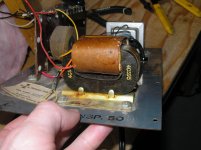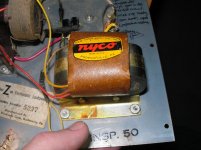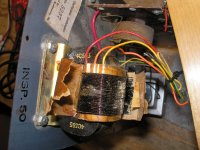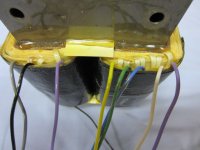I got some Janszen electrostatic speakers and one has an open secondary winding on the audio step up transformer. I was wondering how difficult it would be to rewind it?
I will post a picture of it when I have time.
Thanks,
-bird
I will post a picture of it when I have time.
Thanks,
-bird
One side of the secondary was gone but I measured the impedance to be 625:1 of the good side to center tap.
I wonder if a cheapo 10k:4 push pull transformer will work? It only needs to do from ~600Hz and up.
Maybe have Edcor make a couple 10k:4
EDCOR - XPP10-10K
I wonder if a cheapo 10k:4 push pull transformer will work? It only needs to do from ~600Hz and up.
Maybe have Edcor make a couple 10k:4
EDCOR - XPP10-10K
is it just a snapped lead/wire?
I wish. I think there is a short somewhere.
Que? Which is it? Short or open secondary? Flat Earth or Globular? Haha!
Hahaha nobody will let me forget about the infamous flat earth debate. Love it!!
I can't read continuity from one secondary tap to center tap nor end to end. When I energize the primary with a low voltage transformer the audio transformer pulls 3 amps with all the secondaries floating.
I came across this in my interweb research for transformers.
ELECTROSTATIC LOUDSPEAKER TRANSFORMERS
Anybody use these for their electrostats?
ELECTROSTATIC LOUDSPEAKER TRANSFORMERS
Anybody use these for their electrostats?
I think you are saying you are energizing with a 60Hz signal. Likely you are saturating the core if the 60Hz voltage is more than 2 or 3 Vrms and that is why you are pulling 3 amps. Remember the transformer is designed to only handle frequencies > 1kHz. You could also test the good transformer to see what results to expect. You have nothing to lose by removing the outer layers of insulation to see if the secondary lead wire connection to the fine wire secondary winding has failed as HumbleDeer suggested....When I energize the primary with a low voltage transformer the audio transformer pulls 3 amps with all the secondaries floating.
You might also contact David JansZen to see if he has a suitable replacement transformer.
JansZen Electrostatic Speakers Home
If my memory is correct, those transformers have a step-up ratio of about 50:1.
You could replace them with a pair of small toroidal power transformers with low voltage windings in parallel, and high voltage windings in series as shown in Attachment 3 here:
http://www.diyaudio.com/forums/planars-exotics/286989-about-take-esl-plunge-29.html#post4752565
A pair of these 6V transformers would give you about 64:1, a pair of the 9V transformers about 45:1.
https://www.rapidonline.com/vigortr...ormer-230v-single-primary-15va-0-6v-0-88-5180
https://www.rapidonline.com/vigortr...sformer-230v-single-primary-15va-0-9v-88-5181
I think you are saying you are energizing with a 60Hz signal. Likely you are saturating the core if the 60Hz voltage is more than 2 or 3 Vrms and that is why you are pulling 3 amps. Remember the transformer is designed to only handle frequencies > 1kHz. You could also test the good transformer to see what results to expect.
The good transformer only pulls 400mA when I run the same low voltage test w/ 60Hz. I understand the limitations of the transformer and would completely expect to get core saturation with large amplitudes of such a low frequency.
You have nothing to lose by removing the outer layers of insulation to see if the secondary lead wire connection to the fine wire secondary winding has failed as HumbleDeer suggested.
I attached a picture of the transformer in question. The orange, red and yellow are the secondary wires. Their windings are underneath the primary windings and it's tough to get to them. The red one is the one with the issue.
You might also contact David JansZen to see if he has a suitable replacement transformer.
JansZen Electrostatic Speakers Home
This is another option.
If my memory is correct, those transformers have a step-up ratio of about 50:1.
The good one measures 70:1 w/ a 60Hz signal. I plan today to use a 1kHz sine wave for more testing.
You could replace them with a pair of small toroidal power transformers with low voltage windings in parallel, and high voltage windings in series as shown in Attachment 3 here:
http://www.diyaudio.com/forums/planars-exotics/286989-about-take-esl-plunge-29.html#post4752565
A pair of these 6V transformers would give you about 64:1, a pair of the 9V transformers about 45:1.
https://www.rapidonline.com/vigortr...ormer-230v-single-primary-15va-0-6v-0-88-5180
https://www.rapidonline.com/vigortr...sformer-230v-single-primary-15va-0-9v-88-5181
Good options thank you.
I will report back on some more testing later this afternoon.

Attachments
I hooked up a signal generator and a scope up to the known good transformer.
1kHz @ 1v on the primary gives me a clean 50v sine wave at the secondary from end to end.
Distortion from the 60Hz signal was probably making my digital voltmeter read with gross error? I should have just hooked up the big toys first, I had a 3.15-0-3.15 filament transformer laying right on the bench and my meter was right there too so I just started with them.
They are 50:1 transformers.
1kHz @ 1v on the primary gives me a clean 50v sine wave at the secondary from end to end.
Distortion from the 60Hz signal was probably making my digital voltmeter read with gross error? I should have just hooked up the big toys first, I had a 3.15-0-3.15 filament transformer laying right on the bench and my meter was right there too so I just started with them.
They are 50:1 transformers.
Nice cross-checkThe good transformer only pulls 400mA when I run the same low voltage test w/ 60Hz.

Based on this, sounds like your hunch that the bad transformer has a shorted secondary is correct.
Huh. Well that isn’t very helpful, is it.I attached a picture of the transformer in question. The orange, red and yellow are the secondary wires. Their windings are underneath the primary windings and it's tough to get to them.
Pretty much all of the ESL transformers I have seen route all of the terminal wire connections to the outer insulation layer.
It keeps the winding layers closer together, minimizing leakage inductance. Attached is examples of what I had expected.
Attachments
- Status
- Not open for further replies.
- Home
- Loudspeakers
- Planars & Exotics
- Janszen 1-30



